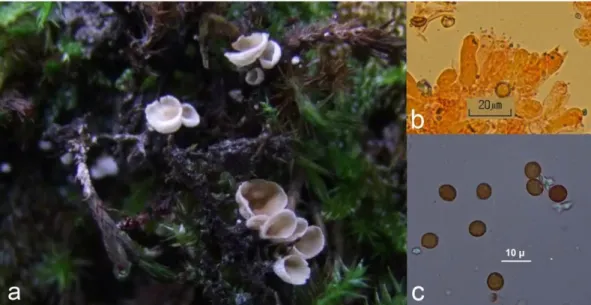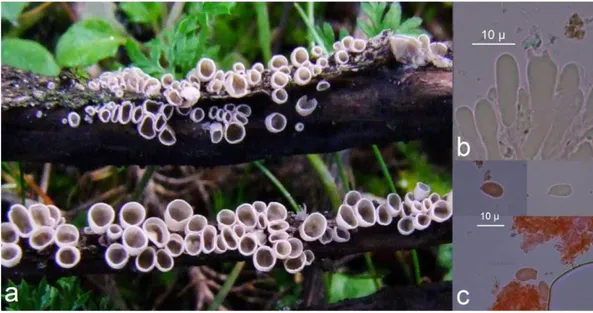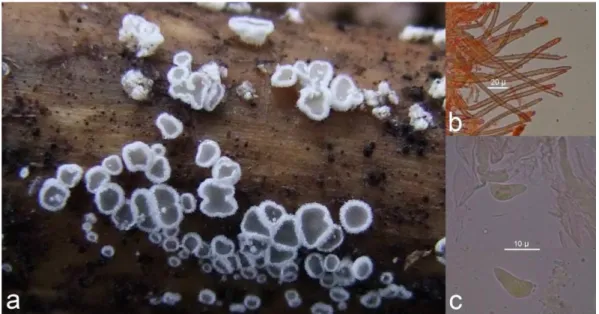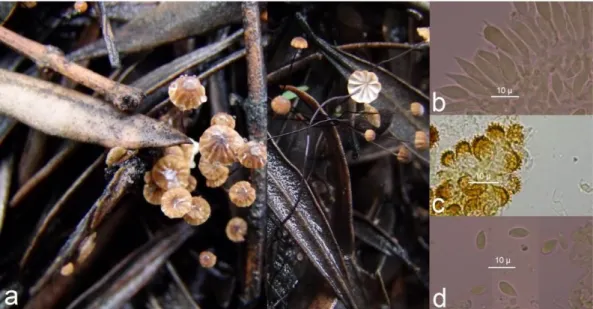www.biodicon.com Biological Diversity and Conservation
ISSN 1308-8084 Online; ISSN 1308-5301 Print
10/2 (2017) 8-13
Research article/Araştırma makalesi
New additions to Turkish Agaricales
Yasin UZUN
1, Abdullah KAYA
*1, İbrahim Halil KARACAN
2, Semiha YAKAR
11
Karamanoğlu Mehmetbey University, Kâmil Özdağ Science Faculty, Department of Biology, 70100, Karaman,
Turkey
2
Ömer Özmimar Religious Anatolian High School, 27220, Gaziantep, Turkey
AbstractSix members of Agaricales, Chromocyphella muscicola (Fr.) Donk (Chromocyphellaceae), Crepidotus pallidus
(Berk. & Broome) Knudsen (Inocybaceae), Mycena meliigena (Berk. & Cooke) Sacc. (Mycenaceae), Lachnella villosa
(Pers.) Donk (Niaceae), Cryptomarasmius corbariensis (Roum.) T.S. Jenkinson & Desjardin (Physalacriaceae) and
Typhula setipes (Grev.) Berthier (Typhulaceae) are recorded for the first time from Turkey. The taxa are described
briefly and photographs related to macro and micromorphologies are given.
Key words: new records, Chromocyphella, Cryptomarasmius, Agaricales, Turkey
--- ---
Türkiye Agaricales’lerine yeni ilaveler
Özet
Altı Agaricales üyesi, Chromocyphella muscicola (Fr.) Donk (Chromocyphellaceae), Crepidotus pallidus
(Berk. & Broome) Knudsen (Inocybaceae), Mycena meliigena (Berk. & Cooke) Sacc. (Mycenaceae), Lachnella villosa
(Pers.) Donk (Niaceae), Cryptomarasmius corbariensis (Roum.) T.S. Jenkinson & Desjardin (Physalacriaceae) and
Typhula setipes (Grev.) Berthier (Typhulaceae) Türkiye’den ilk kez kaydedilmiştir. Taksonlar kısaca betimlenmiş ve
makro ve mikro morfolojilerine ilişkin fotoğrafları verilmiştir.
Anahtar kelimeler: yeni kayıtlar, Chromocyphella, Cryptomarasmius, Agaricales, Türkiye
1. Introduction
Agaricales Underw. is a fungal order of the phylum Basidiomycota R.T.Moore. It is also known as gilled
mushrooms, forming the most crowded order of Agaricomycetes Doweld with about 13000 described species belonging
to 33 families 413 genera (Kirk et al., 2008). The order contains the most familiar types of mushroom species, ranging
from the ubiquitous common mushroom to the deadly destroying angel as well as hallucinogenic fly agarics and
bioluminescent mushrooms. Species of Agaricales are widespread and diverse on land ranging from desert, grassland,
forests, tundra, and shorelines in tropical, temperate, and arctic-alpine habitats.
Until the February 2014, 1943 macrofungi species, majority of which belong to Agaricales, have been recorded
from Turkey (Sesli and Denchev, 2014). Many contributions (Akata et al., 2014; Güngör et al., 2014; Acar et al., 2015;
Doğan and Öztürk, 2015; Kaya, 2015; Sesli et al., 2015; Sesli and Moreau, 2015; Uzun et al., 2015; Akata et al., 2016;
Demirel et al., 2016; Güngör et al., 2016; Öztürk et al., 2016; Sesli and Topçu Sesli, 2016a; 2016b; Sesli et al., 2016)
were also made to this list till now. Here we peresent six basidiomycetous taxa within the order Agaricales as new
records for the mycobiota of Turkey.
The study aims to make a contribution to the macrofungi of Turkey by adding new records.
2. Materials and methods
Fungi samples were collected from localities within the boundaires of Gaziantep province in 2014. They were
photographed in their natural habitats and necessary morphological and ecological properties were noted and then they
were taken to the laboratory and macroscopic and microscopic investigations were carried out on them. Photographs
related to microscopic structures were obtained under Nikon eclipse Ci trinocular light microscope by DS-Fi2 digital
camera. Identification was performed with the help of Breitenbach and Kränzlin (1986;1991), Siepe (1991), Dâmon
(2001), Piatek and Bujakiewicz (2004), Albuquerque et al. (2007), Dam and Boomsluiter (2009), Antonin and
Noordeloos (2010), Friebes (2010), Derboven et al. (2012) and Jenkinson et al. (2014). Specimens are kept at
Karamanoğlu Mehmetbey University, Kamil Özdağ Science Faculty, Department of Biology, Karaman, Turkey.
3. Results
Basidiomycota R.T. Moore
Agaricomycetes Doweld
Agaricales Underw.
Chromocyphellaceae Knudsen
Chromocyphella muscicola (Fr.) Donk
Synonym: Arrhenia muscicola (Fr.) Quél., Calyptella muscicola (Fr.) Quél., Chaetocypha muscicola (Fr.)
Kuntze, Cyphella fuscospora Curr. ex Cooke, Cyphella muscicola Fr., Cyphella muscicola Fr., var. muscicola,
Phaeocyphella fuscospora (Curr. ex Cooke) Rea, Phaeocyphella muscicola (Fr.) Rea.
Macroscopic and microscopic features: Fruiting body 1-5 mm across, cyphelloid to discoid, usually facing
downwards, sessile or slightly stipulate, finely woolly, silky white. Hymenial surface smooth to slightly wrinkled, white
when young later beige or brownish by spores (Figure 1a). Basidia 35-42 × 8-9 μm, cylindric to clavate (Figure 1b).
Spores 7.5-9.5 × 6.5-8.5 μm, spherical to broadly elliptic, thick walled and finely warty generally with a clear apiculus
(Figure 1c). Chromocyphella muscicola grows on or near dead or dying mosses or parasitic on living mosses on the
bark of living trees (Dam and Boomsluiter, 2009).
Specimen examined: TURKEY—Gaziantep: İslahiye, Kuşçumustafa village, pine forest, on moss,
37°06′N-36°37′E, 890 m, 18.10.2014, K.9976.
Figure 1. Chromocyphella muscicola: a. basidiocarps, b. basidia, c. basidiospores
Inocybaceae Jülich
Crepidotus pallidus (Berk. & Broome) Knudsen
Synonym: Calyptella pallida (Berk. & Broome) Quél., Chaetocypha bloxamii (Berk. & W. Phillips) Kuntze,
Chaetocypha pallida (Berk. & Broome) Kuntze, Cyphella bloxamii Berk. & W. Phillips, Cyphella bloxamii Berk. & W.
Phillips, var. bloxamii, Cyphella bloxamii var. disciformis Pilát, Cyphella pallida Berk. & Broome, Pellidiscus pallidus
(Berk. & Broome) Donk.
Macroscopic and microscopic features: Fruiting body 1-3.5 mm across, bowl shaped, attached to the
substrate at the bottom, thin, soft and fragile, white to cream fibrous to fringed, margin somewhat turned into bowl.
Hymenial surface smooth to somewhat rough, greyish white to yellowish cream when young, becomes ochraceous
when mature (Figure 2a). Basdia 13-14 × 5.5-6 μm, cylindrical to clavate usually with four sterigmata (Figure 2b).
Spores 6.5-9 × 3.5-5.5 μm, elliptical to subamigdaliform (Figure 2c). Crepidotus pallidus grows on old leaves and twigs
on marshy or damp ground (Derboven et al., 2012).
Specimen examined: TURKEY—Gaziantep: Nurdağı, Olucak village, mixed forest, on dead twigs,
37°09′N-36°40′E, 980 m, 30.11.2014, K.10831.
Mycenaceae Roze
Mycena meliigena (Berk. & Cooke) Sacc.
Synonym: Agaricus meliigena Berk. & Cooke, Mycena meliigena f. alba Courtec., Mycena meliigena (Berk. &
Cooke) Sacc. f. meliigena, Prunulus meliigena (Berk. & Cooke) Murrill.
Macroscopic and microscopic features: Pileus 4-9 mm across, hemispherical, parabolical to convex,
depressed centrally, radially striate or sulcate, vinaceous red to red-brown (Figure 3a). Flesh thin. Lamellae concolorous
with the pileus at first, become whitish to cream when mature, broad, adnate to subdecurrent. Stipe 10-18 0.3-1 mm,
cylindric, usually bent upward, white pruinose especially toward the base. Cheilocystidia 15-25 x 6-15 µm, clavate,
covered with unevenly spaced, simple or branched excrescences (Figure 3b). Basidia 30-35 10.5-13.5 µm clavate with
4 sterigmata and basal clamp. Spores 8-11 8-9.5 µm, subglobose, smooth, hyaline (Figure 3c). Mycena meliigena
grows on bare, mossy, or lichen-covered bark of living hardwoods (Breitenbach and Kränzlin, 1991).
Specimen examined: TURKEY—Gaziantep: İslahiye, Kuşçumustafa village, pine forest, on pine barks,
37°06′N-36°37′E, 890 m, 18.10.2014, K.9969; Hasanlök village, mixed forest, on pine barks, 36°54′N-36°34′E, 810 m,
19.10.2014, K.10034.
Figure 2. Crepidotus pallidus: a. basidiocarps, b. basidium, c. basidiospores
Niaceae Jülich
Lachnella villosa (Pers.) Donk
Synonym: Cyphella villosa (Pers.) P. Crouan & H. Crouan f. villosa, Cyphella villosa subsp. solenioides P.
Karst., Cyphella villosa (Pers.) P. Crouan & H. Crouan subsp. villosa, Cyphella villosa var. cycadearum Henn.,
Cyphella villosa (Pers.) P. Crouan & H. Crouan, var. villosa, Dasyscyphus sessilis Gray, Henningsomyces villosus
(Pers.) Kuntze, Lachnea villosa (Pers.) Gillet, Peziza granuliformis Pers., Peziza granuliformis Pers., var.
granuliformis, Peziza granuliformis var. incarnata (Pers.) Pers., Peziza granuliformis var. villosa (Pers.) Pers., Peziza
incarnata Pers., Peziza sessilis Sowerby, Peziza villosa Pers., Peziza villosa var. candida Alb. & Schwein., Peziza
villosa var. incarnata (Pers.) Pers., Peziza villosa Pers. var. villosa, Sclerotium villosum Tode, Sclerotium villosum Tode
var. villosum, Solenia villosa (Pers.) Fr., Solenia villosa var. eximia Sacc. & Trotter, Solenia villosa var. polyporoidea
Peck, Solenia villosa (Pers.) Fr. var. villosa, Trichopeziza villosa (Pers.) Fuckel.
Macroscopic and microscopic features: Fruiting body 0.4-1.3 mm across, disc to cup shaped, sessile to
subsessile, surface densely covered with whitish hairs, margin inrolled when dry, hymenial surface smooth, whitish to
pale greyish brown (Figure 4a), marginal hairs thick walled, hyaline, cylindrical and with fine granules (Figure 4b).
Basidia 40-55 × 10-12.5 µm, clavate with four sterigmata. Spores 7-12 × 5-8 µm, amygdaliform, asymmetrical, smooth,
thin-walled and usually with numerous oil drops (Figure 4c). Lachnella villosa grows on herbaceous plants and twigs of
woody plants (Piatek and Bujakiewicz, 2004).
Specimen examined: TURKEY—Gaziantep: Oğuzeli, centre, poplar grove, on dead Populus L. sp. twig,
36°58′N-37°30′E, 700 m, 13.12.2014, K.11066.
Figure 4. Lachnella villosa: a. basidiocarps, b. Basidiospores
Physalacriaceae Corner
Cryptomarasmius corbariensis (Roum.) T.S. Jenkinson & Desjardin
Synonym: Agaricus corbariensis Roum., Marasmius corbariensis (Roum.) Sacc.
Macroscopic and microscopic features: Pileus 2-9 mm across, convex, hemispherical to plano-convex,
obtuse or with a small central umbo, dark brown in the center, degrading towards yellowish in the margin, surface
smooth with deep radial grooves. Flesh thin, membranaceous. Lamellae distant, white, cream to yellow-cream. Stipe
10-30 × 0.2-0.3 mm, filiform, black, slightly pruinose (Figure 5a). Basidia 23-30 × 8-9.5 μm, clavate, with four
sterigmata (Figure 5b). Pileipellis is made up of broadly fusiform to subglobose diverticulately warted elements(Figure
5c). Some of the cheilocystidia, like pileipellis, clavate to pyriform 10-24 × 5-12 µm, hyaline with a variable number of
small, pale yellow-brown 2.5 × 1 µm large warts. Spores 8-10 × 3,5-5,5 µm, ellipsoid to subcylindrical (Figure 5d).
Cryptomarasmius corbariensis grows on rot leaves of broad-leaved plants such as Olea L., Myrtus L. and Quercus L.
(Lantieri et al., 2009).
Specimen examined: TURKEY—Gaziantep: Nizip, Sekili village, cemetary, on dead Olea L. sp. leaves,
36°58′N-37°40′E, 600 m, 14.12.2014, K.11114.
Figure 5. Cryptomarasmius corbariensis: a. basidiocarps, b. Basidiospores
Typhulaceae Jülich
Typhula setipes (Grev.) Berthier
Synonym: Clavaria gyrans Batsch, Clavaria setipes Grev., Cnazonaria setipes (Grev.) Corda, Pistillaria
setipes Grev., Typhula grevillei Fr., Typhula gyrans (Batsch) Fr., Typhula gyrans var. grevillei (Fr.) Massee, Typhula
gyrans (Batsch) Fr. var. gyrans.
Macroscopic and microscopic features: Fruiting body 2-4 × 0.2-0.5 mm, consists of a fertile head and a
sterile stalk, head 0.5-1× 0,2-0,5 mm, whitish to cream colored, capitate, smooth. Stipe 2-2.2× 0,2 mm, cylindrical,
whitish with a thickened and reddish brown base, always much longer than the head (Figure 6a). Basidia 22-30 × 5-6
µm, slenderly conical with two to four sterigmata (Figure 6b). Spores 7-9 × 3-3,5 µm, elliptical, smooth, hyaline
(Figure 6c). Typhula setipes grows on decaying fallen leaves of various hardwoods (Breitenbach and Kränzlin, 1986).
Specimen examined: TURKEY—Gaziantep: Yavuzeli, Halilbaşlı village, stream side, on dead Populus L. sp.
twig, 37°16′N-37°31′E, 560 m, 02.11.2014, K.10497; Oğuzeli, centre, roadside, poplar grove, on dead Populus L. sp.
leaves, 36°58′N-37°30′E, 700 m, 13.12.2014, K.11059, K.11063.
Figure 6. Typhula setipes: a. basidiocarps, b. basidia, c. basidiospores
4. Conclusions and discussion
With this study, Chromocyphella muscicola (Fr.) Donk, Crepidotus pallidus (Berk. & Broome) Knudsen,
Mycena meliigena (Berk. & Cooke) Sacc., Lachnella villosa (Pers.) Donk, Cryptomarasmius corbariensis (Roum.) T.S.
Jenkinson & Desjardin and Typhula setipes (Grev.) Berthier were added as new records for the mycobiota of Turkey.
Chromocyphella muscicola is the first member of Chromocyphellaceae Knudsen in Turkey. Cryptomarasmius
corbariensis is also the first member of the genus Cryptomarasmius T.S. Jenkinson & Desjardin. Lachnella
alboviolascens (Alb. & Schwein.) Fr., and Typhula fistulosa (Holmsk.) R.H. Petersen are the second members of the
members of both genera increased to two. Meanwhile the current taxa numbers of the genera Crepidotus (Fr.) Staude
and Mycena (Pers.) Roussel also increased to 11 and 63 respectively.
Acknowledgements
The authors would like to thank TUBİTAK (KBAG 212T112) for its financial support.
References
Acar, İ., Uzun, Y., Demirel, K., Keleş, A. (2015). Macrofungal diversity of Hani (Diyarbakır/Turkey) district. Biological Diversity and Conservation, 8 (1), 28-34.
Akata, I., Uzun, Y., Kaya, A. (2014). Macromycetes determined in Yomra (Trabzon) district. Turkish Journal of Botany, 38(5), 999-1012.
Akata, I., Uzun, Y., Kaya, A. (2016). Macrofungal diversity of Zigana Mountain (Gümüşhane/Turkey). Biological Diversity and Conservation, 9(2), 57-69.
Albuquerque, H.R., Araújo, J.P.M., Putzke, J. (2007). Chromochyphella muscicola (Fr.) Donk. (Basidiomycota, Agaricales): Primeira citação para o Brasil. Revista Brasileira de Biociências, Porto Alegre 5(supl. 2), 999-1001.
Antonin, V. and Noordeloos, M.E. (2010). A monograph of marasmioid and collybioid fungi in Europe. IHW-Verlag D-85387 Eching, 480 p.
Breitenbach, J., Kränzlin, F. (1986). Fungi of Switzerland. Vol: 2, Non gilled fungi. Verlag Mykologia CH-6000 Luzern 9, 420 p. Breitenbach, J., Kränzlin, F. (1991). Fungi of Switzerland. Vol: 3, Boletes and agarics. Verlag Mykologia CH-6000 Luzern 9, 361 p. Dam, N., Boomsluiter, M. (2009). Fairy rings in moss. Coolia, 52(2), 67-72.
Dâmon, W. (2001). Notizen zur Pilzflora des Bundeslandes Salzburg (1). Linzer biol. Beitr., 33(2), 723-796.
Demirel, K., Acar, İ., Ömeroğlu Boztepe, G. (2016). Lice (Diyarbakır) Yöresi Makrofungusları. The Journal of Fungus, 7(1), 29-39. Derboven, P.P., Fraiture, A., Ghyselinck, D., Mertens, C. (2012). Une excursion printanière des plus intéressantes. Bull. Assoc.
Mycol. francoph. Belgique, 5, 5-12.
Doğan, H.H., Öztürk, Ö. (2015). Six new Russula records from Turkey. Mycotaxon, 130(4), 1117-1124.
Friebes, G. (2010). Die Gruppe der Rinden-Helmlinge (Mycena) in der Steiermark und ein Schlüssel der europäischen Arten. Joannea Botanik, 8, 43-58.
Güngör, H., Solak, M.H., Allı, H., Işıloğlu, M. (2016). Contributions to the macrofungal diversity of Hatay province, Turkey. Biological Diversity and Conservation, 9(1), 101-106.
Güngör Yaratankul, M., Güngör, H., Solak, MH. 2014. New Crepidotus (Fr.) Staude record for Turkish mycota. Biological Diversity and Conservation (BioDiCon) 7(2): 127–128.
Jenkinson, T.S., Perry, B.A., Schaefer, R.E., Desjardin, D.E. (2014). Cryptomarasmius gen. nov. established in the Physalacriaceae to accommodate members of Marasmius section Hygrometrici. Mycologia, 106(1), 86-94.
Kaya, A. (2015). Contributions to the macrofungal diversity of Atatürk Dam Lake basin. Turkish Journal of Botany, 39(1), 162-172. Kirk, P.M., Cannon, P.F., Minter, D.W., Stalpers, J.A. (2008). Dictionary of the Fungi, 10th ed. Wallingford, UK: CAB
International.
Lantieri, A., Gargano, M.L., Venturella, G. (2009). The sabulicolous fungi from Sicily (southern Italy): additions and critical review. Mycotaxon, 110, 151-154.
Öztürk, Ö., Doğan, H.H., Şanda, M.A. (2016). Some new additions to Turkish mycobiota from Sakarya region. Biological Diversity and Conservation, 9(1), 97-100.
Piatek, M., Bujakiewicz, A. (2004). Lachnella villosa and Woldmaria filicina, two remarkable cyphellaceous fungi from Poland. Polish Botanical Journal, 49 (2), 145-150.
Sesli, E., Contu, M., Vila, J., Moreau, P.E., Battistin, E. (2015). Taxonomic studies on some agaricoid and boletoid fungi of Turkey. Turkish Journal of Botany, 39(1), 134-146.
Sesli, E.,Denchev, C.M. (2014). Checklists of the myxomycetes, larger ascomycetes, and larger basidiomycetes in Turkey. 6th edn.
Mycotaxon Checklists Online. (http://www.mycotaxon.com/resources/checklists/sesli-v106-checklist.pdf): 1-136.
Sesli, E., Moreau, P.A. (2015). Taxonomic studies on some new fungal records from Trabzon, Turkey. Turkish Journal of Botany, 39(5), 857-866.
Sesli, E., Topçu Sesli, A. (2016a). A new genus record (Tephroderma) for the Turkish mycota. Biological Diversity and Conservation, 9(2), 202-206.
Sesli, E., Topçu Sesli, A. (2016b). Türkiye için üç yeni kayıt: Chalciporus piperatoides, Gymnopus menehune ve Lyophyllum shimeji. The Journal of Fungus, 7(1), 61-66.
Sesli, E., Türkekul, İ., Akata, I., Niskanen, T. (2016). New records of Basidiomycota from Trabzon, Tokat, and İstanbul provinces in Turkey. Turkish Journal of Botany, 40(5), 531-545.
Siepe, K. (1991). Two Typhula species of the subgenus Cnazonaria: T. lutescens and T. setipes. Zeitschrift für Mykologie, 57(1), 11-15.
Solak, M.H., Işıloğlu, M., Kalmış, E., Allı, H. (2015). Macrofungi of Turkey Checklist Vol II. Üniversiteliler ofset, İzmir.
Uzun, Y., Kaya, A., Karacan, İ.H., Kaya, Ö.F., Yakar, S. (2015). Macromycetes determined in Islahiye (Gaziantep/Turkey) district. Biological Diversity and Conservation, 8(3), 209-217.



